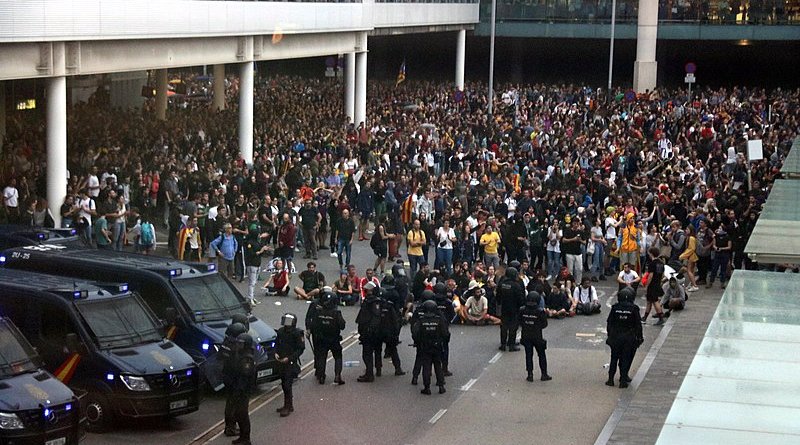Spain: What Impact Did Police Violence Have On Participation In October 1, 2020 Catalan Referendum?
Beaten ballots: political participation dynamics amidst police interventions is the title of the academic article by Toni Rodon and Marc Guinjoan, lecturers of Political Sciences at UPF and the UB, respectively, which seeks to look in greater depth at the effects of police interventions regarding political participation, taking the “repression-mobilization” nexus debate as a starting point.
The study, published recently in the Cambridge University Press journal Political Science Research and Methods, focuses on the analysis of the referendum on independence held in Catalonia on 1 October 2017, when despite the police crackdown, 2,286,217 people voted, representing 44% of the electorate.
The research stresses the study of an aspect that has been largely ignored in the academic literature: the spatial dynamics triggered by violence in political mobilization. That is, whether the police violence on participants has a positive or a negative effect at the places where it occurs and nearby areas.
Toni Rodon, a professor with the UPF Department of Political and Social Sciences and member of the Research and Expertise Centre for Survey Methodology (RECSM-UPF), and Marc Guinjoan, a doctor of Political and Social Sciences from UPF and currently a postdoctoral researcher at the UB Institutions and Political Economy Research Group (IPERG), claim that, in the referendum of 1-O, “although the police raids had a negative impact on local participation, it induced positive spillover effects in nearby areas”. According to them, “our findings indicate heterogeneity in spatial dynamics: police actions encouraged people to go to vote in nearby areas, but it also mobilized the residents of these neighbouring areas, especially those with less incentives to go to vote”.
The study uses quantitative and qualitative methods with aggregate data relating to polling stations that were visited by the police (with or without violence), a geo-survey conducted by the Centre d’Estudis d’Opinió (CEO – centre conducting surveys on public opinion) a few days after the referendum, and interviews held with members of the police forces. These interviews have enabled the authors to ascertain the micromechanisms of the logic behind the police action, which facilitated their research.
Moving to neighbouring areas and the activation of new voters in protest
The study estimates that although the state police forces managed to reduce the number of votes cast in the municipalities where they took action (around 14-15 percentage points, on average), participation in surrounding areas increased. The greatest effect was felt in municipalities some ten kilometres from the affected spots, where turnout was 6.2% higher than average. About 25 percent of this increase in participation was due to the activation of new voters, while the remaining 75 per cent can be explained by people living in areas raided by the police who travelled to neighbouring areas, which was possible due to the ‘universal census’ whereby any voter could vote at any polling station.
Among the “new voters”, the authors calculate that there was a large proportion of undecided or ambivalent voters, not clearly in favour of Catalan independence but with dual sense of national identity. “Our interpretation of this pattern is that some people who identify equally with Catalonia and Spain, for whom the likelihood of participating in the referendum or travelling to another town to vote was low, became angry and mobilized after seeing police violence in neighbouring municipalities”, the researchers assert. According to Toni Rodon, “police violence did not make certain people change from being unionists/federalists to Catalan separatists overnight, but it did mobilize them as a means of protest or civil disobedience”.
The police went from following general instructions to acting randomly
Another section of the study focuses on analysing the patterns followed by police action, i.e., why the police went to some areas and not to others: “Before finding out the effects of police actions on participation, we needed to know if their treatment (police violence) was random. Otherwise, it would have been very difficult to identify the effect of violence on participation”, Toni Rodon states. And he adds: “As the interviews reveal, the police logically designed an initial plan that was not random (let us recall their actions at the polling stations where the pro-independence leaders voted, for example). However, the day’s events ended up making many of their actions random”.
The study shows that there is no common policy variable or one that indicates a particular pattern regarding police intervention, either with respect to municipality size or density, turnout for previous elections or support for separatism, profile of the citizens, etc. The agents interviewed acknowledged that the plans changed suddenly the morning of the referendum, once the difficulty had been realized of closing polling stations and confiscating ballot boxes due to the mobilization by the citizens and the activation of the ‘universal census’. “The initial goal of preventing a large number of voters from voting suddenly became unviable”, the researchers affirm.
Toni Rodon and Marc Guinjoan emphasize that the conclusions they have drawn with this study are very close in line with recent research that has been conducted in other contexts that tends to demonstrate that “police brutality often fails to change what ‘partisans think, but this does not mean that they will not react against it when they find it excessive”.

